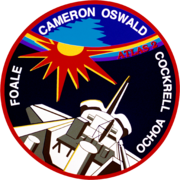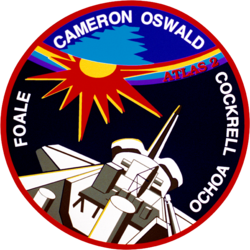STS-56
| STS-56 | |||||
 | |||||
| Uppdrag | ? | ||||
|---|---|---|---|---|---|
| Rymdfärja | Discovery (16)[1] | ||||
| NSSDC-ID | 1993-023A[2] | ||||
| Färdens tid | 9 dagar, 6 timmar, 8 minuter, 24 sekunder | ||||
| Uppskjutning | |||||
| Startplats | Startplatta 39B vid Kennedy Space Center i Florida | ||||
| Start | 8 april 1993, 1:29:00 a.m. EDT | ||||
| Landning | |||||
| Landningsplats | KSC runway 33 | ||||
| Landning | 17 april 1993, 7:37:19 a.m. EDT | ||||
| Omloppsbana | |||||
| Varv | 147 st[3] | ||||
| Apogeum | 299 km | ||||
| Perigeum | 291 km | ||||
| Banlutning | 57° | ||||
| Sträcka | 6,202 miljoner km | ||||
| Besättning | |||||
| Befälhavare | Kenneth D. Cameron (2) | ||||
| Pilot | Stephen S. Oswald (2) | ||||
| Uppdragsspecialister | C. Michael Foale (2) Kenneth D. Cockrell (1) Ellen Ochoa (1) | ||||
 | |||||
| Kronologi Rymdfärjeprogrammet | |||||
| |||||
STS-56 var en flygning i det amerikanska rymdfärjeprogrammet med rymdfärjan Discovery. Den sköts upp från Pad 39B vid Kennedy Space Center i Florida den 8 april 1993. Efter drygt nio dagar i omloppsbana runt jorden återinträdde rymdfärjan i jordens atmosfär och landade vid Kennedy Space Center.
Besättning
Se även
Referenser
- ^ NASA Space Shuttle Launch Archive Arkiverad 25 september 2012 hämtat från the Wayback Machine., läst 28 juli 2016.
- ^ ”NASA Space Science Data Coordinated Archive” (på engelska). NASA. https://nssdc.gsfc.nasa.gov/nmc/spacecraft/display.action?id=1993-023A. Läst 19 mars 2020.
- ^ Manned Astronautics - Figures & Facts Arkiverad 16 augusti 2016 hämtat från the Wayback Machine., läst 28 juli 2016.
Externa länkar
 Wikimedia Commons har media som rör STS-56.
Wikimedia Commons har media som rör STS-56.
| ||||||||
| ||||||||||||||||||||||||||||||||
Media som används på denna webbplats
Författare/Upphovsman: Pascal (Flickr user: pasukaru76), Licens: CC0
Vostok spacecraft replica at the Technik Museum Speyer, Germany.
STS-54 Mission Insignia
STS-55 Mission Insignia
STS-56 Mission Insignia
The STS-56 crew portrait includes five astronauts. Seated from the left are Stephen S. Oswald, pilot; and Kenneth D. Cameron, commander. Standing, from the left, are mission specialists Kenneth D. Cockrell, C. Michael Foale, and Ellen Ochoa. The crew launched aboard the Space Shuttle Discovery on April 8, 1993 at 1:29:00 am (EDT) with the Atmospheric Laboratory for Applications and Science-2 (ATLAS-2) as the primary payload.







